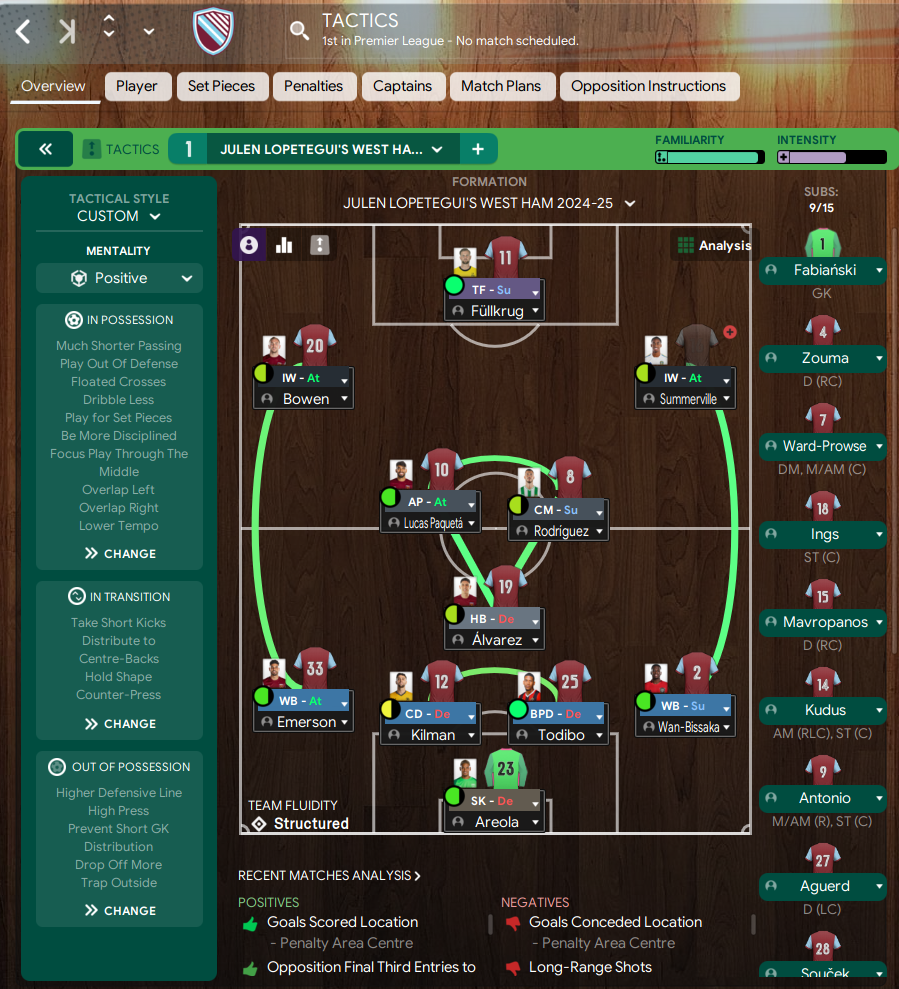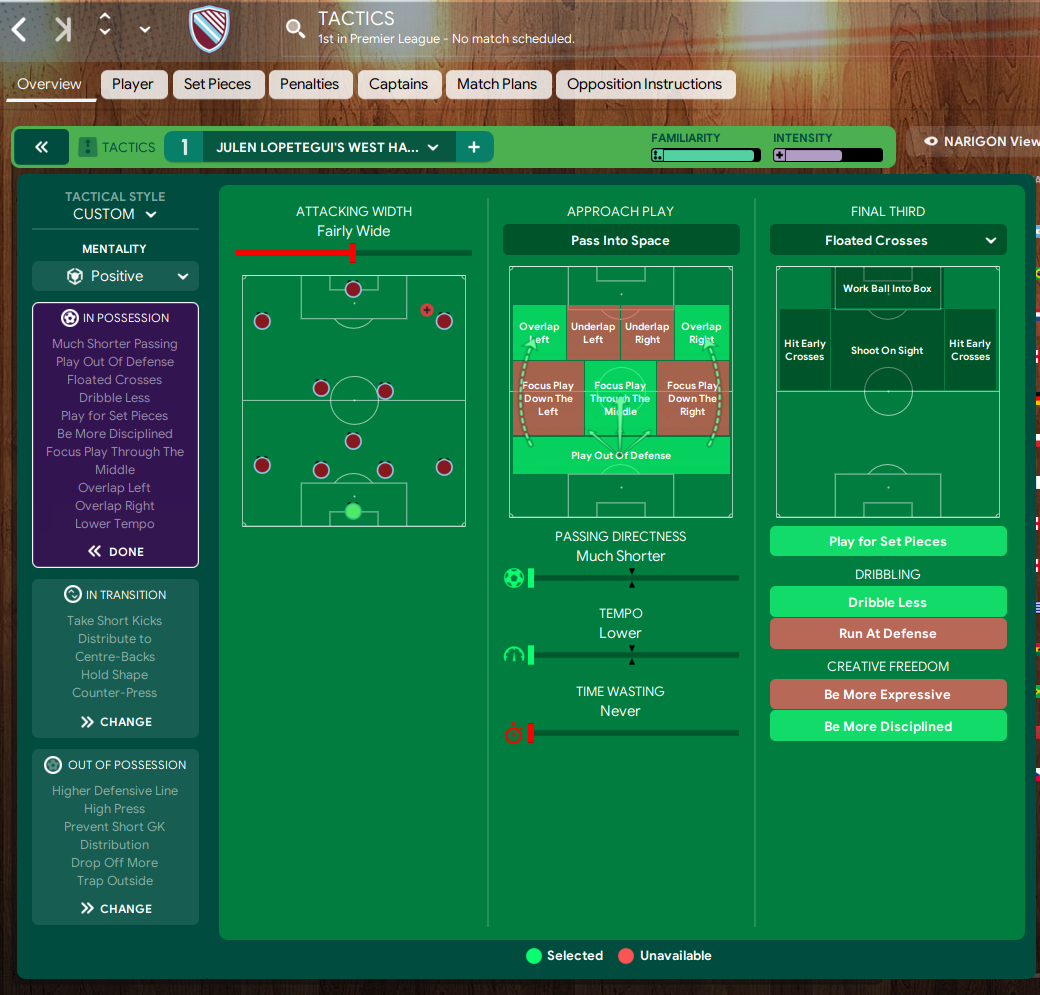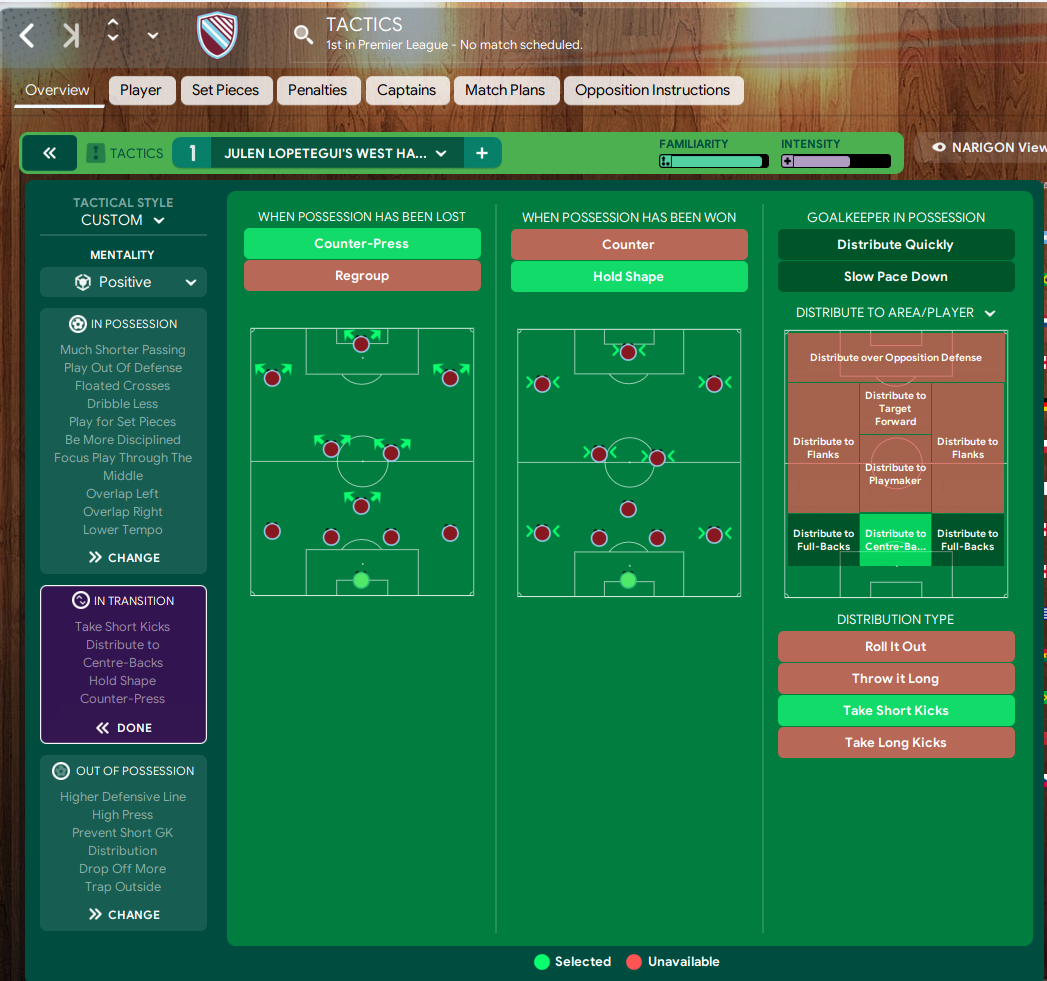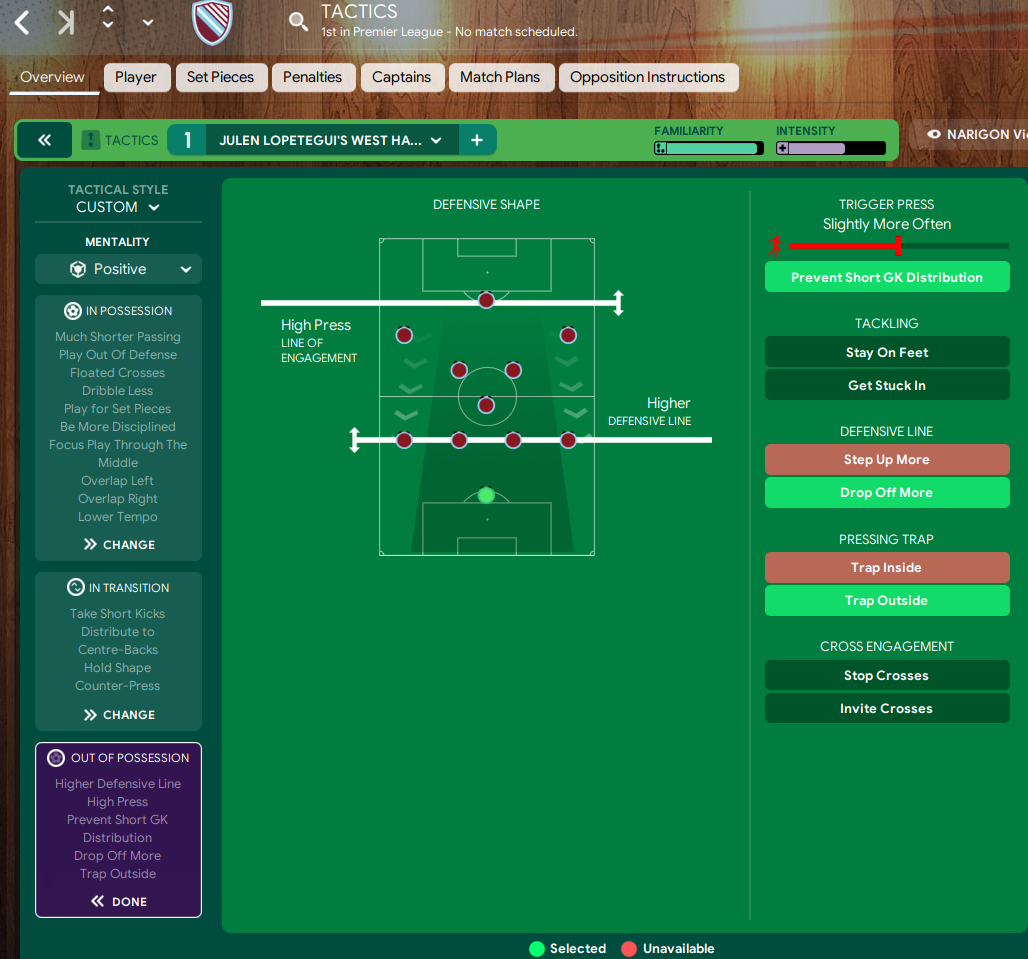| Tester | Team | ME | Win % | PPG | AGF | AGA | GD | PL | W | D | L | |
|---|---|---|---|---|---|---|---|---|---|---|---|---|
| Deleted User #1866315 |
 West Ham
West Ham
|
24.3 | 74% | 2.37 | 2.2 | 0.7 | 1.53 | 38 | 28 | 6 | 4 |
JULEN LOPETEGUI’S WEST HAM 2024-2025 VISION
Hi everyone, this time I'm bringing you an analysis of Julen Lopetegui, focusing on his past experiences with Sevilla, the Spanish national team, and Wolves. How might West Ham shape up under his guidance?
West Ham have secured their new head coach, and on the surface, he appears to be the progressive tactician that fans were hoping for.
Lopetegui enjoyed significant success at Sevilla, achieving three consecutive top-four finishes and winning the UEFA Europa League. He also managed to lift Wolverhampton Wanderers from the bottom of the Premier League to a safe mid table finish in the 2022/23 season.
While Lopetegui's tactics represent a clear shift from the low-block, cautious football of his predecessor, David Moyes, this appointment might not entirely satisfy West Ham supporters who are eager to see more attacking play at the London Stadium.
Lopetegui's teams are often solid but not spectacular, possession-oriented but slow, and while effective, they aren't known for their attacking flair.
The key statistic: In LaLiga, Lopetegui’s teams scored 181 goals in 131 matches, averaging 1.38 goals per game. By contrast, Moyes’s West Ham have netted 248 goals in 169 Premier League games since his return, with an average of 1.47 goals per match.
While there's more to football than just goals, they remain a good measure of how entertaining a team is. Wolves fans, though appreciative of Lopetegui’s achievements, wouldn’t describe his brand of football—23 goals in 23 league games—as particularly thrilling.
Nonetheless, Lopetegui has a strong track record, and the tactical shift he’ll bring to West Ham could be a refreshing change.
Possession Football and Low-Scoring Games
In Possession
Julen Lopetegui is best characterized as a coach who prioritizes possession, believing that “controlling the game and securing victory is easier with the ball.” His preferred 4-3-3 formation exemplifies this philosophy—a balanced and adaptable setup that empowers his teams to dominate possession, dictate tempo, and create numerical advantages in crucial areas of the pitch.
The core of this system lies in the three-man midfield, the driving force behind any Lopetegui team. This midfield trio typically includes a defensive midfielder, a playmaker, and a shuttler, each fulfilling distinct roles. The shuttler operates between both penalty areas, serving as an outlet for quick one-twos, facilitating play under pressure, and helping move the ball wide. The playmaker, equally vital in the build-up phase, maintains the rhythm and aids the transition from defense to attack through incisive, line-breaking passes.
The defensive midfielder is crucial, enabling two key aspects of Lopetegui’s style: building from the back and maintaining width through the full-backs. By dropping between the center-backs, the defensive midfielder offers an additional passing option during the initial stages of possession, helping the team circulate the ball comfortably at the back until forward passing lanes emerge. This also frees up the full-backs to advance while ensuring there’s sufficient defensive cover if possession is lost.
When building up, the goal is often to draw the opposition to one side of the pitch, creating space for players on the opposite flank to receive a long switch in open areas—a tactic reminiscent of Declan Rice’s switches to Jarrod Bowen during his time at West Ham. If a switch isn’t feasible, the team is instructed to progress through the thirds, manipulating the opposition’s structure until openings appear on the flanks, in the channels, or behind the defense.
In the final third, fluidity, interchanging positions, and overloads are central to creating chances. Wingers often drift into the half-spaces while the striker roams, drawing defenders out of position and opening gaps for teammates to exploit. Meanwhile, the full-backs push forward into advanced wide areas to deliver crosses into the box for the striker and an arriving midfielder to attack. During Lopetegui’s first season with Sevilla in 2019/20, his team led La Liga with 23.2 crosses per 90 minutes.
Given West Ham’s strengths, including the elite half-space play of Jarrod Bowen and Mohammed Kudus, overlapping full-backs like Vladimír Coufal and Emerson, and Edson Álvarez, a defensive midfielder adept in possession and breaking up attacks, Lopetegui’s approach could seamlessly integrate into the team’s style.
Out of Possession
Lopetegui is also known for his ability to craft solid defenses. His out-of-possession tactics are meticulously planned, focusing on strong organization, high intensity, and structured pressing, making his teams tough to break down. His Sevilla side, for example, boasted one of La Liga’s best defenses, finishing the 2019/20 and 2021/22 seasons with the third-best defensive record and leading the league in 2020/21 by conceding only 34.8 xGA (0.92 per 90).
Defensively, Lopetegui often employs a 4-3-3 or 4-2-3-1 formation, which effectively covers the pitch while allowing flexibility to adapt to different phases of play and opposition setups. When pressing, his teams often transition to a 4-4-2, similar to the approach West Ham fans have seen under David Moyes. In this system, an advanced central midfielder moves up to join the striker in the first line of pressure, a consistent feature of Lopetegui’s defensive strategy designed to disrupt build-up play and force mistakes.
However, Lopetegui isn’t rigid in his formations, acknowledging that “formations are no longer so important in football,” with “styles and decision-making” often dictating outcomes. This balance between idealism and pragmatism was evident in Wolves’ 3-0 home win against Liverpool last season, where Lopetegui opted for a more cautious 4-4-2 with a deeper defensive line to neutralize Liverpool’s transition threat, limiting them to just two shots on target from 22 attempts.
Disciplined center-backs are essential in Lopetegui’s system, leading from the back by maintaining the team’s shape and adjusting the defensive line height based on the opposition’s threats. Their positioning is key to defending against direct play and runs in behind, which can challenge high defensive lines. The defensive midfielder helps mitigate this risk by stepping up to close down attackers or dropping back alongside the center-backs to guard against aerial threats. This high line strategy reduces the area in which the opposition can play, suffocating their build-up and forcing errors in dangerous areas.
By compressing the central zones and forcing the opposition wide, Lopetegui’s teams make it harder for opponents to create meaningful chances. This congestion, combined with the support of a high defensive line, enhances the team’s ability to counter-press effectively—a strength of James Ward-Prowse, who excelled in a similar system under Ralph Hasenhüttl at Southampton, where he was among the top Premier League midfielders for pressing and recovering possession.
Pressure starts from the front with the striker, who directs the ball to one side while the wide players on that side provide support. The midfield trio then blocks passes back inside, creating opportunities for early turnovers in the opposition’s build-up phase. This approach could be particularly effective for Mohammed Kudus, who recorded the most recoveries per 90 minutes among forwards in the Premier League this season, with 7.68, ranking fourth overall.
Lopetegui’s past experiences at Sevilla and Wolves
Lopetegui adheres to two core principles: defensive solidity and possession control.
Operating in a 4-3-3 or 4-2-3-1 formation, he expects his teams to dominate possession, using short passes to circulate the ball between defense and midfield, effectively keeping the opposition at bay through possession.
This low-tempo approach often leads to low-scoring games, as a strong defense is paired with a cautious, possession-based attack. It’s no surprise that Lopetegui was chosen to succeed Vicente del Bosque as Spain's manager.
Sevilla’s defense reached its peak in Lopetegui’s final season, conceding the fewest goals in the league (30) and achieving an impressive 22 clean sheets.
But this wasn’t a case of sitting back. Sevilla employed a mid-block rather than a deep one and were effective at counter-pressing. However, once they regained possession, they rarely exploited spaces in transition, making Lopetegui an outlier in modern football.
Instead, Sevilla often recycled the ball, leading to low goal-scoring numbers.
Wolves’ Attempt to Emulate Sevilla’s Style
This approach continued at Wolves, where they managed just 23 goals in 23 Premier League matches under Lopetegui. During his tenure, Wolves recorded the league’s lowest expected goals (xG) tally at 22.1 and created the fewest "big chances" with 21.
Wolves averaged 50.2% possession, struggling to maintain the control Lopetegui desired. Still, their number of 10+ open-play passing sequences and passes per sequence were among the best in the league, suggesting the intent was there.
At West Ham, who are looking to evolve from Moyes’s tactics, Lopetegui will aim to implement his possession-based style, likely pushing closer to the 60% possession mark. Unlike at Wolves, he’ll have the resources and time to achieve this.
Switches, Flying Full-Backs, and Midfield Rotations
While there were some minor differences between Lopetegui's Sevilla and Wolves teams, they predominantly played similarly, even in the finer details.
From a foundation of slow possession and strong counter-pressing, Lopetegui's teams rely on flying full-backs for width, narrow midfield rotations, and frequent diagonal switches to create crossing opportunities.
All this possession tends to compress the pitch, leading to switches of play aimed at wide areas for crosses.
Adaptability and Tactical Reactivity
While Lopetegui’s broad tactical approach can be predicted, it's important to note his adaptability. Lopetegui significantly adjusted to the challenge of lifting Wolves from the bottom of the table.
Wolves held less possession than Sevilla, playing a more direct style, and occasionally shifting from a 4-3-3 or 4-2-3-1 to a 4-4-2, allowing for quicker transitions to the forward line.
Lopetegui's adaptability and meticulous preparation for each opponent have earned him a reputation as a superb tactician, drawing comparisons to Aston Villa’s Unai Emery.
However, his teams can sometimes appear overly structured, lacking creativity when the system becomes too rigid—a factor that contributed to his brief tenure at Real Madrid.
Preseason results and what I understood after watching some highlights
Preseason results can be misleading, especially with a new manager like Lopetegui. Often, the true potential of a team isn't fully realized until the regular season begins. For example, last season Bournemouth started slowly before finding their rhythm.
Considering the current financial pressures, the ongoing transfer window, and international tournaments like Copa America and the Euros, many teams might not be fully prepared in the first month of the season.
In their first preseason match against Ferencvaros, the Hungarian champions, West Ham’s lineup mostly consisted of established players, with only a few new signings. However, this lineup revealed one of Lopetegui's several plans for the upcoming season. The 4-3-3 formation they used focused heavily on the midfield's role, both in and out of possession. The midfield trio, consisting of James Ward-Prowse, Lewis Orford, and Freddy Potts, took turns retrieving the ball from defense, creating challenges for opponents trying to mark them man-to-man.
Out of possession, West Ham’s midfield stayed narrow and compact, making it difficult for opponents to penetrate through the middle. However, this positioning also leaves them vulnerable to long balls over the top, which was evident in their preseason matches against Crystal Palace and Wolves, where they suffered 3-0 defeats. Despite these losses, it's essential not to overreact to preseason results, as players are still getting fit, adjusting to new tactics, and dealing with challenging conditions.
Against Wolves, West Ham stuck with a 4-3-3 formation, but they switched to a different setup against Crystal Palace, resulting in a 3-1 defeat. The vulnerabilities of their midfield positioning were exposed, particularly against long balls. This could be a concern moving forward, as their high line and compact midfield may struggle against quick counterattacks.
Despite these issues, West Ham's new signings offer exciting prospects. Edson Alvarez will be crucial in patrolling the midfield and addressing the defensive weaknesses. Meanwhile, players like Cresencio Summerville, who was one of the best in the EFL last season, bring additional flair and unpredictability to the team. Somerville’s playstyle differs from traditional wingers, making him a valuable asset for Lopetegui.
Another significant addition is Aaron Wan-Bissaka, known for his defensive prowess. Although not the most attacking fullback, his ability to win one-on-one duels will be vital, particularly when West Ham's defense faces pressure. Lastly, the signing of striker Niclas Füllkrug, who has experience in high-pressure situations like the Champions League, adds a new dimension to their attack.
With these new additions, West Ham’s lineup is shaping up to be quite formidable. The combination of established players and exciting new signings provides depth and versatility. The key will be how Lopetegui integrates these players into his system and how they adapt to his tactics.
In summary, West Ham's offseason moves have the potential to transform the team into a formidable force in the Premier League. The blend of tactical innovation and quality signings suggests they could be one of the most exciting teams to watch this season. However, their success will depend on how well they address their defensive vulnerabilities and adapt to the challenges of the Premier League.
HOW TO REPLICATE THIS TACTIC IN FOOTBALL MANAGER 2024
To emulate this tactic in Football Manager 2024, I started from a 4-3-3 formation and a positive mentality.
As said before, Lopetegui’s approach emphasizes patience, building attacks from the back, dominating possession, often using short, precise passing to maintain control of the ball. He aims to suffocate opponents and prioritizing defensive solidity, this strategy allows his teams to dictate the pace of the game and control the flow, though it sometimes leads to fewer goal-scoring opportunities.
So, in possession, we will have a fairly wide attacking width because Lopetegui typically prefers a balanced approach, even if the midfield is narrow, full-backs and wingers will provide width. Of course, overlap left and right will also be important instructions. Focus play through the middle will help our players to narrow the pitch and overload spaces in the central areas, while width and crosses will be provided by the two wing-backs
Play out of defense, much shorter passes and lower tempo to retain possession as much as possible, but you can change it to slightly shorter and lower if you want to play in a less boring way.. Lopetegui is very careful in defense, that’s why I chose to be more disciplined.
In the final third, since Lopetegui wants his players to be patient, I selected dribble less and play for set pieces. This helps our team to retain possession and also to get important scoring opportunities exploiting set pieces. Besides,during his reign at Sevilla, El-Nesyri benefited a lot of crosses and with Fullkrug as new West Ham forward, floated crosses can be a perfect option. For this reason, despite it being a possession based tactic, I don’t ask our players to work the ball into the box, but I leave them free to decide.
In transition, gegenpressing is a must (counter-press) because Lopetegui wants his players to win the ball back as soon as possible, but after they won the ball they will restart playing patiently and maintaining possession and as you know, in Football Manager you can do so by selecting the “hold shape” instruction.
Out of possession, high defense and high pressing line to restrict the gap between the lines and press the opponent high. Pressing will not be very aggressive because Lopetegui wants his team to avoid being caught off-guard by long balls, so this time I’ll go for a slightly more often pressing combined with drop off more, trap outside.
Player roles and instructions
Gk: Areola: Sweeper-keeper (defend)
Wing-backs
We want our two full-backs to be extremely aggressive and provide all the width, but Wan-Bissaka’s peerless defensive qualities can be more useful if we set his duty to support
RFB: Wan-Bissaka: Wing-back ( support): cross more often, run wide with the ball, stay wider.
LFB: Emerson Palimeri: Wing-back in attack : cross more often, run wide with the ball, stay wider.
Central defenders
For Lopetegui, central defenders must lead the defensive line and they must know where to stay higher and when to drop deeper instead. One defender can help more in building the play while the other will have only defensive tasks. If we want to create a back three in possession with a midfielder dropping deep between the two central defenders, we can ask both to stay wider and cover spaces left by the wing-backs.
RCD: Todibo: Ball-playing defender (defend): stay wider
LCD: Kilman: Central defender (defend): stay wider, take fewer risks. He will focus only on defending and we don’t want him to lose the ball or leave space behind him so we ask him to take fewer risks.
Defensive midfielder
Edson Alvarez’s role. He will be responsible for dropping deeper between the two central defenders to create a back trio and also to cover spaces left behind by the midfielders. Besides, he will help in possession. The right role for him is a half-back.
DM: Edson Alvarez: Half-back- defend: mark tighter, close down more, take fewer risks.
Central midifelder
The midfielder trio is the core of Lopetegui’s formation, both in attack and defense. They must help in possession and attack and also cut the opponent’s passing line, besides, they must be careful not to be caught off-guard by long balls.
RCM: Guido Rodriguez: central midfielder-support: he will stay wider to cover spaces left by the right wing-back. For this reason, you can also choose a carrilero role for him, but I chose the central midfielder role because it has more instructions available for editing. So I will instruct him to stay wider, mark tighter, close down more.
LCM: Lucas Paquetà: Advanced playmaker-attack: roam from position, get further forward, close down more and tackle harder.
As mentioned in the analysis above, when pressing, Lopetegui’s teams often transition to a 4-4-2. In this system, an advanced central midfielder moves up to join the striker in the first line of pressure, a consistent feature of Lopetegui’s defensive strategy designed to disrupt build-up play and force mistakes.This will be Paqueta’s task
Wingers
Lopetegui likes inverted wingers and this is why we must use the inverted winger role here.
RW: Kudus (or Bowen): Inverted winger-attack: roam from position, shoot more often, sit narrower, close down more.
LW: Summerville: Inverted winger-attack: sit narrower, close down more, shoot more often, roam from position.
Striker
Lopetegui likes forwards who drop down and link the play, with Fullkrug, he has the perfect target forward who will press, disrupt the opponent’s play when they build from the back and link the play, creating spaces and opportunities for his teammates, especially wingers.
CF: Fullkrug: Target forward-support (you can use attack too here): roam from position, move into channels, shoot less often.
Test Results
 West Ham
West Ham
You'll need to Login to comment




